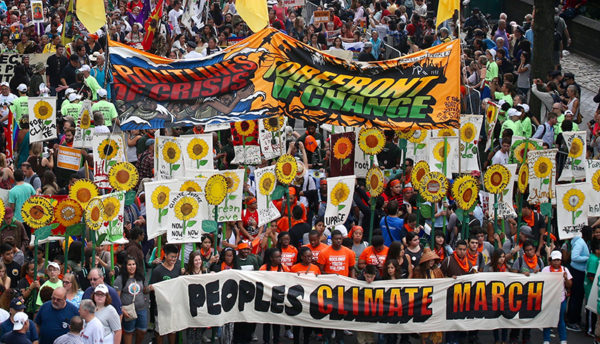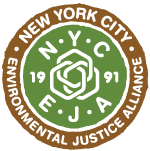
More than 400,000 people march through midtown Manhattan on Sunday, September 21, 2014 as part of the People’s Climate March, a worldwide mobilization calling on world leaders meeting at the UN to commit to urgent action on climate change and 100% clean energy, Sunday, Sept. 21, 2014, in New York. (John Minchillo/AP Images for AVAAZ)
Climate change impacts everyone, everywhere – but the effects of climate change are not distributed equally. Frontline communities, from across the United States and the Global South, are most vulnerable to climate change and must therefore play an integral role in planning for transformational change.
In the winter of 2014, NYC-EJA, our members and other key partners began organizing a response to U.N. Secretary-General Ban Ki-moon’s call for world leaders to gather at a global Climate Summit in September 2014. That response became the People’s Climate March – the cornerstone of a week of grassroots action in response to U.N. Secretary General Ban Ki-moon’s challenge.
NYC-EJA was a key partner and co-coordinator of the historic People’s Climate March – a climate mobilization unmatched in size, diversity, and impact. With an estimated 400,000 participants, 1,500 organizational sponsors, and over 2,000 solidarity marches and rallies across the globe, the People’s Climate March in September 2014 was the largest climate march in history.
NYC-EJA’s participation in the People’s Climate March was an extension of our work advocating for community resiliency and climate justice in New York City’s low-income communities and communities of color. As a member of the Climate Justice Alliance, we are working with frontline communities across the United States to address climate change and advocate for a just transition. As a co-facilitator of the NY-NJ Host Committee, NYC-EJA helped build a growing network of labor unions, environmental justice organizations, social justice, community-based organizations, faith-based organizations, organizers, artists, and environmentalists to mobilize for the People’s Climate March. For more information see NYTimes article: Taking a Call for Climate Change to the Streets.
With the advent of the Trump administration, which has declared its intent to withdraw from the 2015 Paris agreement, the People’s Climate Movement (the successor formation of the People’s Climate March) mobilized another mass march in April 2017.
In 1995, NYC-EJA created the first green jobs apprenticeship program in New York City, the Minority Workers Training Program. NYC-EJA is a co-founder of the New York City Apollo Alliance and is a partner in their living wage green jobs campaign in NYC; at the State level, NYC-EJA works with the Center for Working Families on NYS green jobs strategies.
Projections show that within the next 10 years, Con Edison will not have the capacity to meet the peak energy needs for all of Brooklyn. Energy usage in Brooklyn is growing, and projections show that within the next 10 years, Con Edison’s Brownsville 2.0 substation will not have the capacity to meet the peak energy needs for communities in Bushwick, Bedford Stuyvesant, East New York, Cypress Hills, Crown Heights, East Flatbush, and Brownsville. Within this impacted zone, 90 percent of residents are people of color; 76 percent residents have a median household income below $30,000, and 68,880 people reside in 66 NYCHA housing developments. Increased load demand could mean losing power when we need it most, especially during heat waves when air conditioners are blasting, and after storm surges that disrupt outdated energy infrastructure.
To meet this energy shortfall, Con Edison and the NY Public Service Commission developed a program called The Brooklyn Queens Demand Management (BQDM), now known as the Neighborhood Program, to reduce demand by 52 Megawatts by reducing the load during times of peak demand; increasing energy efficiency in buildings and appliances; and investing in long-term solutions such as new, low-energy building designs. This new approach may represent a fundamental change in how communities get electricity. However, we need meaningful community involvement address critical questions around public health, local air quality, economic development and energy efficiency.
In response to Con Ed’s program, NYC-EJA and our member the Brooklyn Movement Center formed the Brooklyn Alliance for Sustainable Energy (BASE), a coalition of community-based planning organizations from Brooklyn working for cleaner sources of energy and a more efficient and resilient energy infrastructure. BASE advocates for the following principles: 1) Transparent decision-making and implementation process, 2) Strong provisions to control the environmental justice impacts of projects on vulnerable communities, and 3) A diverse, equitable energy market in compliance.
To learn more about the New Energy Demands in Brooklyn and Con Edison’s plans to address them see NYC-EJA’s fact sheet and Comments to the New York State Public Service Commission regarding the Con Edison Brooklyn ‐ Queens Demand Management program.
NYC-EJA and its members were key stakeholders and participants in the Bloomberg Administration’s creation of PlaNYC 2030, New York City’s long-term growth and sustainability plan, which has become an international model for large cities. NYC-EJA has also worked with the City Council on several key PlaNYC initiatives, including the Greener, Greater Buildings Plan (the first comprehensive, mandatory effort by an American city to reduce emissions from existing large buildings) and congestion pricing.
NYC-EJA is working with members and ally organizations on several brownfield policy initiatives, including continued implementation of the City’s Office of Environmental Remediation and proposals for state and federal collaborations.
There are numerous brownfields in New York City, with a majority located within the low-income communities of color that NYC-EJA serves. A brownfield is land previously used for industrial purposes or certain commercial uses, which may be – or perceived to be – contaminated by low concentrations of hazardous waste or pollution. The perceived or actual contamination complicates the reuse or redevelopment of a brownfield, raising possible liability concerns for developers and investors (land that is more severely contaminated and has high concentrations of hazardous waste or pollution, such as a Superfund site, does not fall under the brownfield classification.) Often the only develop-able land remaining in low-income communities, brownfields are clustered due to a history of industrial use, illegal dumping and/improper storage and handling of commercial products. Brownfields take many forms such as abandoned gas stations, vacant lots, empty manufacturing plants and auto shops. NYC-EJA and its members are involved in a range of brownfield remediation, development and advocacy efforts throughout our communities.
In March 2010, Mayor Bloomberg appointed the NYC Charter Revision Commission to comprehensively review and recommend changes to the City Charter for voter referenda approval. A critical policy area for environmental justice advocates is the fair share provision of the Charter. Introduced during the 1989 Charter Revision, fair share was intended to prevent the precipitous siting of offensive city facilities on overburdened communities without thorough review, prior notice in a Citywide Statement of Needs and community consultation. City government subsequently gutted the fair share provisions via rule-making. In 2010, NYC-EJA successfully advocated that the Charter Revision Commission propose an amendment to include all public and private waste and transportation infrastructure facilities on the City’s “Fair Share” map. 83% of New Yorkers who voted on the November 2010 ballot questions approved this amendment.
In 2011, NYC-EJA was invited by Governor Cuomo’s Office and the NYS Assembly to provide advice for the re-authorization of Article X (New York State’s power plant siting law, which expired in 2003). Known as the Power NY Act, NYC-EJA worked with allies NY Lawyers for the Public Interest, NYPIRG, and Environmental Advocates of NY to ensure the new Article X law provided the strongest protections for environmentally overburdened communities of color. Power NY mandated (for the first time) the development of environmental impact analyses that measure a community’s total environmental load before a power plant siting can be approved. More importantly, Power NY mandated that the NYS Department of Environmental Conservation promulgate regulations for the State’s first ever “disproportionate burdens” analyses. If a community is found to be disproportionately burdened, power plant applicants will have to commit to local, verifiable offsets of any projected pollution emissions before the power plant can be sited, thereby easing the burden on our most vulnerable communities.
NYC-EJA’s Open Space Equity Project successfully documented open space disparities for communities of color and advocated that the City create new playgrounds and waterfront parks in underserved neighborhoods.
The Climate Justice Alliance, including the New York City Environmental Justice Alliance, Indigenous Environmental Network and other allies, hosted a two-day People’s Climate Justice Summit following the People’s Climate March in September 2014. The summit was concurrent with the Climate Leaders Assembly convened by the UN General Secretary Ban Ki Moon in New York City. The Summit delegates convened at the UN Church Center, directly across the street from the UN, and the proceedings were live-streamed for public viewing at The New School on both days. The Summit convened a meeting of frontline community delegations from across the U.S. and around the world – that are both organizing against the root causes of climate change, and cultivating real solutions to address these causes. For more information see archived videos of the People Climate Justice Summit.
For environmental justice communities, resiliency is not about “bouncing back” to an inequitable system where people of color and low-income people are disproportionately burdened. Resiliency means “bouncing forward” to a more just, more sustainable future.
NYC-EJA is actively working to leverage the momentum of the March to achieve long-term resiliency goals in New York City. As part of the People’s Climate March planning, NYC-EJA, our members and allies successfully engaged with Mayor de Blasio’s Administration and the New York City Council to unveil bold climate policy initiatives to coincide with the People’s Climate March. NYC-EJA and our member organizations are committed to building on the promise of the March to effect tangible change in our communities. In the lead up to the March, the City showed signs of commitment to continued engagement on climate issues:
- The NYC Council approved a resolution endorsing the People’s Climate March;
- The NYC Council announced a comprehensive platform to combat climate change and to reduce the city’s carbon footprint through a set of legislative proposals; and
- Mayor de Blasio announced an unprecedented plan to reduce greenhouse gas emissions by 80% in NYC by 2050 (known as “80 by 50”).
NYC-EJA members and our allies in vulnerable communities will continue to advocate for policies that result in long-term benefits to community resiliency. The long-term horizon for resiliency planning makes it challenging to advocate for public policies that advance healthy, sustainable communities while addressing existing economic, social, and environmental disparities.
For more information on similar initiatives, see NYC-EJA’s Waterfront Justice Project and Community Resiliency.
